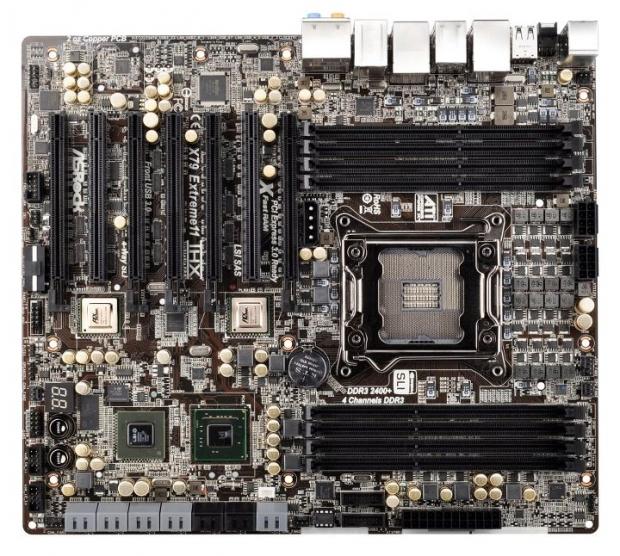ASRock has announced a monster board the ASRock X79 Extreme11 and are really pulling out all stops with this motherboard. This could be of interest to those requiring a workstation board that is a crossover with server board features. The main feature that caught my eye is the onboard dual core LSI SAS 2308 SAS 2 /SATA III controller that is included on the motherboard. It is the newer/ faster version of the LSI SAS 2008 controller as seen in the now famous IBM M1015.
The included dual core LSI SAS 2308 is a PCIe v3.0 compliant device and offers a dual core controller. As this board is not yet released there is a question regarding how the onboard LSI SAS 2308 is attached to the system and if it will allow full PCIe v3.0 bandwidth and if it can be passed through for Intel VT-d purposes.
The ASRock X79 Extreme11 motherboard has two PLX8747 GEN3 (PCIe v3.0) bridge chips, each attached to the LGA2011 PCIe v3.0 x16 lanes which allow the board to have a lot of effective PCIe connectivity. Given PCIe v3.0 is still new, add-in cards are unlikely to utilize all of the bandwidth it provides, so a switched architecture at this point makes a lot of sense. This gives the motherboard seven PCIe 16x slots, for Quad SLI/4 way Crossfire support or a myriad of add-in cards. The ASRock X79 Extreme11’s LGA2011 platform already has 40 PCIe 3.0 lanes, not including the PCIe bridge chips. As a result, we hope that the onboard dual core LSI SAS 2308 controller is not sitting on the PCIe 3.0 bridge chips which would allow for lower latency.
There is another PLX bridge chip spotted on the motherboard, this being a PCIe v2.x device. Hopefully this is not connected to the LSI SAS 2308 controller. Mostt likely the “other” bridge chip powers the other PCIe devices that are onboard (ie LAN and USB 3.0.) Another question will be how many lanes will the LSI SAS 2308 controller be given by ASRock. It is possible the dual core LSI SAS 2308 is given four lanes because the company does not feel users will provide additional bandwidth. No mater how many lanes it will have or which PCIe version, the board has 14 SATA connectors which is great for those that need large, high performance RAID arrays. It would have been very nice if ASRock included a pair of MiniSAS (SFF-8087) connectors to hook up to drives, SAS expanders and etc.
ASRock X79 Extreme11 has dual LAN ports but no IPMI 2.0 for remote management which is a feature that really puts this into the workstation class motherboard. Overall, a great looking feature set.

While we wait on the boards release, let’s hope ASRock puts out a killer workstation platform with the LSI SAS2308. Let’s also hope we can get one of these in the lab!




Can’t wait to see your review of this ASRock board
Hi,
to use my sas drives which cable I need to use?
Ugo